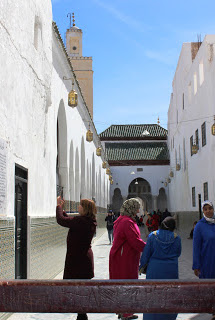Our next destination was Morocco's holiest city and most important pilgrimage destination: Moulay Idriss. If a Moroccan comes here seven times in his/her lifetime, it makes up for never making the very expensive pilgrimage to Mecca.
What makes this city so important is that it surrounds the mausoleum of Moulay Idriss himself, the great-grandson of the Prophet Muhammad and the man who brought Islam to Morocco in 789 AD. Idriss was heir to the caliphate in Damascus, but after a civil war there that led to the Shia-Sunni divide, he fled to Morocco and established the first Arab dynasty there. He also began building the city of Fes, which was finished by his son, Moulay Idriss II. Idriss I was poisoned in 792 by his enemies in the East, but he left behind a pregnant wife, and when his son was old enough, he followed in his father's footsteps.
Moulay Ismail rebuilt the tomb of Moulay Idriss I in the late 17th/early 18th century, creating today's grand pilgrimage mausoleum. The eponymous town is often referred to as Moulay Idriss Zerhoun (Zerhoun being the name of the mountain upon which it is built). I'm guessing that's to distinguish it from the man himself.
What makes this city so important is that it surrounds the mausoleum of Moulay Idriss himself, the great-grandson of the Prophet Muhammad and the man who brought Islam to Morocco in 789 AD. Idriss was heir to the caliphate in Damascus, but after a civil war there that led to the Shia-Sunni divide, he fled to Morocco and established the first Arab dynasty there. He also began building the city of Fes, which was finished by his son, Moulay Idriss II. Idriss I was poisoned in 792 by his enemies in the East, but he left behind a pregnant wife, and when his son was old enough, he followed in his father's footsteps.
Moulay Ismail rebuilt the tomb of Moulay Idriss I in the late 17th/early 18th century, creating today's grand pilgrimage mausoleum. The eponymous town is often referred to as Moulay Idriss Zerhoun (Zerhoun being the name of the mountain upon which it is built). I'm guessing that's to distinguish it from the man himself.
You would think a city of such great importance to Moroccans would be large and noisy and glamorous, but it's a quiet, humble, compact place with a population of about 12,000. Built on the side of a hill, it almost feels like Tuscany--almost. Like most Moroccan towns, it has a large central square, but at least when we were there, it was pretty quiet:
The tomb of Moulay Idriss I is at the end of this long corridor:
Unfortunately (but completely understandably for such a holy site), "Access is not permitted fro non-Muslims":
In fact, non-Muslims were not even permitted to stay overnight in this holy city until 2005. When the American author Edith Wharton visited here in 1919, she had to be out of the city by 3:00 PM.
A heavy wood bar blocks the entrance, perhaps to stop tourists from inadvertently wandering in when no one is watching, or perhaps to keep out the omnipresent donkeys. People can bend and crawl under, but not donkeys.





















